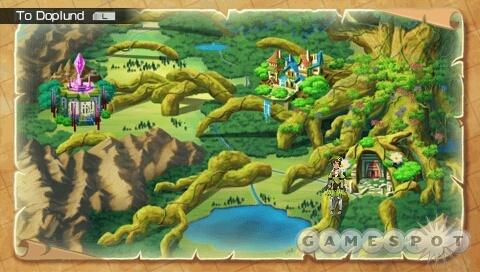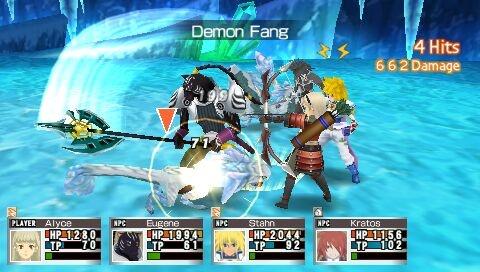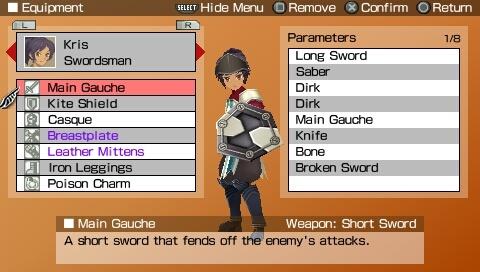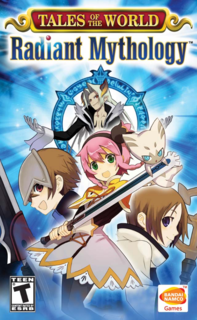-----------------------------------------------------------------------------------------
Game Title: Tales of the World Radiant Mythology
Platform: PlayStation Portable
Developer: Alfa System
Publisher: Bandai Namco Games, Ubisoft
Genre: Role Playing
Age Rating: CERO: B, ESRB: T for Teen, PEGI: 12+
Release Date: December 21st 2006 (Japan), July 17th 2007 (North America), September 6th 2007 (Australia), September 7th 2007 (Europe)
-----------------------------------------------------------------------------------------
Game Score: 7.4/10
-----------------------------------------------------------------------------------------
Summery:
It's a good crossover game that almost shines well but however some things didn't go all the way.
-----------------------------------------------------------------------------------------
Crossover video games have had quite a history, these types of games have mainly stuck to fighting games such as Marvel VS Capcom or Super Smash Bros. Rarely you would be able to see a crossover tend to the RPG genre much in a way like Kingdom Hearts. Back in 2002 to 2005 Namco partnered with Alfa System to develop Tales of the World Narikiri Dungeon 2 and 3 which were Tales related crossover games that never got released outside Japan. However the PSP finally manages to get its very first and currently only Tales crossover game in English in the form of Tales of the World Radiant Mythology, in order to gain the appeal of western fans. It comes out as a crossover game that has potential but doesn't do enough to carry them.

Unlike many of the Tales games where the games focused on a more single player experience, Radiant Mythology features quest design that makes the game resemble an MMO RPG, but without the online component obviously a little like Final Fantasy XII but though almost much better designed. When you first start the game you are instructed to create your main character by selecting the gender, voice, name, face looks and finally the starting class. You are then thrusted into the world of Terresia in which its world tree is slowly losing mana at the hands of the devourer and the citizens are being ruled against their own will. Being created from what was left from the world tree's mana its up to you to enlist into a guild known as Ad Libitum which consists of characters from other Tales of games to help the people and stop the devourer. The character lineup are about 19 from Tales of Phantasia to Tales of the Abyss and each of the characters that you'll meet from those game do share their screentime with the player. The choices for some of the characters is a little questionable, some players may recognise the Phantasia and Symphonia cast like Lloyd, Kratos. Raine, Chester or Arche but however chances are that you never heard of Stahn, Philia, Rutee, Gar, Nanally, Eugene and Annie from Tales of Destiny, Tales of Destiny 2 or Tales of Rebirth. Some fan favourite Tales characters didn't make the list sadly like Cress, Colette, Sheena, Zelos or Jade so you are left with a few less memorable characters but you can still expect some great roles and voice acting dispute Eugene from Tales of Rebirth and the Symphonia Cast besides Kratos having somewhat lazy performances. There is however no option for the original Japanese voicetrack for anyone who doesn't like the English Dub. Many of the cutscenes are good sharing out a few dramas to a few comical moments where they can be entertaining but again some poor voice acting performances tend to hold some of these back.
When you finally get settled into the town and the guild that you will be working with you get to pick out an area that you wish to explore in the towns before going to the guild to pick out one of 5 different quests that you wish to do. Quests range from fetching needed materials, defeating a number of targeted enemies, finding a lost NPC or having a trial battle with the Tales Heroes. After selecting the quest to do you still need to need to client who posted the request and it almost feels unnecessary when the information is already listed on the board, thankfully each client stays in town and they are only a click away which doesn't make the quest system not anywhere near as bad as Final Fantasy XII. Also if you know where the materials are and how to get them you can just select the quest or a different, ignore one of the requested clients and go straight to the dungeon to grind for the materials needed for the next quest to save you time which is very helpful. Thankfully your companions do not actually stop you from doing so but remind you that you have to talk to the client in order to start the quest. Once you complete a quest it's back to the client to receive you reward and then you are off to start off the next one. Once you complete enough fetch quests you can advance the storyline, take on a boss and witness more events about the world and the characters you meet over the course of the game before doing more quests. Thankfully each quest you do in the game is simple and the game is happy to point out where you need to go which is very generous. Tales of the World Radiant Mythology features about 300 quests to complete and thankfully you do not need to complete every single to finish the game but completion of quests awards Gald, Items, Recipes for both Cooking and Crafting and lastly Fame which is needed to advance the story.
The perspective of exploring the dungeons is different from other Tales games, you explore each dungeon from a behind the back third person perspective, (almost like Tales of Xillia 1 and 2 which I did reviews on) each area is designed like a small maze that is separated into different floors where you will find spots on the map where you can dig up raw materials and monsters are visible on the map which like in other games you touch them to start a battle. You can farm for materials using pickaxes and sickles that you can purchase the basic ones in stores and each spot drops a random set of materials that a spot is likely to drop. You will also be able to find treasure chests which can be opened easily while others require you to have one of 3 different types of keys to open it. These are important for completing quests that you decide to do but you can only accept one quest at a time.
Once you get the recipes as rewards you can use the materials you collected to create new items and eventually be able to upgrade weapons and armour that you have in your procession. By crafting new items and upgrading your equipment you gain level up your cooking, forging, attire and tool skills to be able to craft stronger items for later portions of the game. Also with higher levels in crafting and cooking you will have less chances of actually failing and also to note when upgrading equipment with a different type of forging or crafting material you can get your equipment to have stat boosts, reduce your TP usage, grant you additional EXP, Gald, Grade points or have a temporally boost of crafting skills. Remember upgrading equipment using crafting materials is randomized each time so you will be expecting different results which may force you to use the save/load system if you are not happy with the upgrades, also some other weapons that you will find cannot be upgraded and enemies you defeat may drop rare and powerful upgraded versions of equipment which is also great. This not only adds depth to the customization but each type of equipment also changes your character's appearance like in any other MMO, however like in other MMO games the class that a type of equipment that it is for needs to be at the required level to be able to equip it.

Of course the highlight of doing the quests is fighting against various enemies and a boss battle which happens during the storyline, a battle can be started by touching an enemy on the map but if an enemy touches you from behind the battle formation is reversed. Battles take place in real time and it uses features from Tales of Symphonia and Tales of the Abyss. You have the ability to run around freely on the map which is mapped to the Analog Stick while single plane movement and Arte usage are assigned to the D-Pad. As for the other controls R changes target, L is the Shortcut Arte command that you use alongside the D-Pad, X is the physical attack button while Circle combined with the D-Pad uses different Arte abilities, Square Blocks and Triangle brings up the Battle Menu where you change Artes for your character or give a Arte Command. You can also set up Unison attack, change strategy and formation, change equipment which are helpful, you can flee from a battle if you want but sometimes you won't be able to runaway like during boss battles for example and of course you use an item to heal a party member, give a temporally stat boost or use a Magic Lens to get the enemy's data. You can also activate Overlimit by pressing both the L and R buttons and if the conditions are met you can pull of a powerful Mystic Arte which kills most weak enemies instantly. Each time you level up your may learn new Arte abilities while some other Artes requires you to use some of your other ones 50 times before mastering it. Tales of the World Radiant Mythology features 10 different classes that have their own abilities and advantages that you can use in a battle. The 4 starting classes are given to you at the start of the game and you can change classes before heading out to a dungeon once you complete a few story quests while other classes are unlocked by fulfilling conditions at some points of the game.
Also after a few quests you'll get access to recruiting party members and the Unison Attack system where you and your 3 other party members can join together to combine their attacks using the 4 face buttons on the PSP system alongside the D-Pad. You can assign 3 other party members to join you in your current quest which is bound to be a player's requirement for completing some harder quests, or to return to previous areas to grind up a few levels and get materials for more challenging quests. You can recruit 14 out of 19 Tales of related characters or class based mercenary characters into the party at any time before setting off but however sometimes the characters will ignore your request which is annoying sure but in MMO fashion it supposedly emulates real life people not wanting to help you out but luckily it doesn't always happen. You just need to have a high relationship with the other characters in which it is affected by dialogue choices that you make during the cutscenes, doing plenty of quests or spending a lot of time in battles with each character and their affection with you will increase. This allows the player to be able to get close to each of the playable characters and also if you wish you can also take control of one of the characters from the Tales games by going to the Arte screen, putting your main character on auto and going to the other character's Arte screen and set the controls on him/her to play as the Tales character during battles which is great fan service.
As for the Unison Attack it's a watered down version from Tales of Symphonia in which there are no Arte combinations to make note of and a minor flaw is that both Strike and Magic Artes cannot be combined together. By Tales of standards that is rather weird but however it seems almost that the developers wanted to make the battle system a little realistic in a way dispute friendly characters do not get damaged by playable characters spells. Dispute the drawback and the learning curve of the controls the battle system is just as deep as the two Tales games but through it isn't as refined or polished because if you are reasonably levelled and well equipped you won't need to worry about this minor handicap.
The main issue with Tales of the World Radiant Mythology is that you will be spending a lot of time having to do plenty of the same kinds of countless fetching and delivering quests to advance the plot since each material can take quite a while to put together let alone locate. The best of the quests in the game are the character challenges where you are pitted against characters from the other Tales of games and they are very challenging to take down, the same can be said for the optional Radiant quests that you can get at the end of the game if the class you are using is high levelled enough. With 300 quests to do Tales of the World Radiant Mythology will keep you playing for dozens of weeks or months to come to complete them all and gather all the special items ready for a New Game Plus.

On the PSP Tales of the World Radiant Mythology is a good looking game with solid character models, character animations and the various looks that you can select for your main character, the same can be said for the characters from the represented Tales games look great. The storyline cutscenes are told through skit sequences which play out as Anime face portraits which animate showing off the characters emotion during the events that happens. The soundtrack has remixed versions of tunes from old Tales game which are mixed between great and decent and the sound effects are aright but the getting punched sound when someone gets hit by a Magic Spell or Mystic Arte seems wrong.
What Tales of the World Radiant Mythology on the PlayStation Portable does right is recreating a somewhat MMO experience as a single player game but keeping the tried and true Tales of mechanic intact which is a great thing. Sure you do spend most of the time doing the same kinds of fetching and delivering quests but however the battle system although not as refined as Tales of Symphonia or Tales of the Abyss alongside the storyline and many of the characters from other games in the series is enough to make the game worth hours of enjoyment. The game could have included more characters like Cress Albane from Tales of Phantasia, Sheena Fujibayashi from Tales of Symphonia or Jade Curtiss from Tales of the Abyss but there isn't anything much to complain about he roster and there is some fan service to be had with this game.
-----------------------------------------------------------------------------------------
The Good Points:
---------------------
1. 300 quests to play through and the Tales character and Radiant challenges are the best quests in the game
2. Plenty of items and equipment to craft, cook and upgrade
3. Good Battle System combining Tales of Symphonia and Tales of the Abyss even though it's not as refined
4. Being able to fight alongside the Tales of characters is cool
The Bad Points:
---------------------
1. Some weak voice acting with some of the characters and some fan favourite characters didn't make it
2. You spend a lot of time doing the same fetching and delivering quests
3. The getting punched sound effect for getting hit by a Magic Spell sounds wrong
-----------------------------------------------------------------------------------------
Reviewed by: Anthony Hayball (AQWBlaZer91)
-----------------------------------------------------------------------------------------

